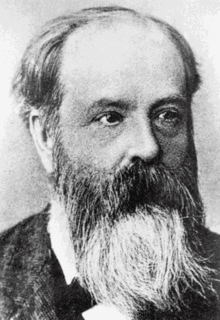Frederick Guthrie
Frederick Guthrie | |
|---|---|
 | |
| Born | 15 October 1833 Bayswater, London |
| Died | 21 October 1886(1886-10-21) (aged 53) London |
| Scientific career | |
| Academic advisors | Augustus De Morgan |
Prof Frederick Guthrie FRS FRSE (15 October 1833 – 21 October 1886) was a British physicist and chemist and academic author.
He was the son of Alexander Guthrie, a London tradesman, and the younger brother of mathematician Francis Guthrie. Along with William Fletcher Barrett he founded the Physical Society of London (now the Institute of Physics) in 1874 and was president of the society from 1884 till 1886.[1][2] He believed that science should be based on experimentation rather than discussion.
Academic career
His academic career started at University College, London, where he studied for three years. He studied chemistry under Thomas Graham and Alexander William Williamson and mathematics under Augustus De Morgan. In 1852, he submitted his brother Francis's observations to De Morgan.[3]
In 1854 Guthrie went to Heidelberg to study under Robert Bunsen and then in 1855 obtained a Ph.D. at the University of Marburg under Adolph Wilhelm Hermann Kolbe.[4]
In 1856 he joined Edward Frankland, professor of chemistry at Owens College, Manchester. In 1859 he went to Edinburgh University.
Guthrie was the first to report on the effects of mustard gas. In 1860, he described combining ethylene with sulfur dichloride and observations of some of the physiological effects it had on him.[5]
In 1860 Guthrie was elected a Fellow of the Royal Society of Edinburgh, his proposer being Lyon Playfair. He was elected a Fellow of the Royal Society of London in 1871.[6]
He served as professor of chemistry and physics at the Royal College of Mauritius between 1861 and 1867.[7]
Guthrie was later a professor at the Royal School of Mines in London, where he mentored the future experimental physicist C. V. Boys. He also mentored John Ambrose Fleming and was instrumental in turning his interest from chemistry to electricity.
He invented the thermionic diode 1873 (this was later given alternate credit to Edison's assistant W. J. Hammer).[8]
Guthrie wrote the Elements of Heat in 1868 and Magnetism and Electricity in 1873 (published in 1876).[9]
Guthrie was also a linguist, playwright, and poet. Under the name Frederick Cerny, he wrote the poems The Jew (1863) and Logrono (1877).
Guthrie died in 1886 and is buried in Kensal Green Cemetery in London.[10]
Family
He was married four times.
His son Frederick Bickell Guthrie was an agricultural chemist.
References
^ Lewis, John J. (2003). The Physical Society and Institute of Physics 1874-2002. Institute of Physics Publishing. ISBN 0-7503-0879-6..mw-parser-output cite.citation{font-style:inherit}.mw-parser-output q{quotes:"""""""'""'"}.mw-parser-output code.cs1-code{color:inherit;background:inherit;border:inherit;padding:inherit}.mw-parser-output .cs1-lock-free a{background:url("//upload.wikimedia.org/wikipedia/commons/thumb/6/65/Lock-green.svg/9px-Lock-green.svg.png")no-repeat;background-position:right .1em center}.mw-parser-output .cs1-lock-limited a,.mw-parser-output .cs1-lock-registration a{background:url("//upload.wikimedia.org/wikipedia/commons/thumb/d/d6/Lock-gray-alt-2.svg/9px-Lock-gray-alt-2.svg.png")no-repeat;background-position:right .1em center}.mw-parser-output .cs1-lock-subscription a{background:url("//upload.wikimedia.org/wikipedia/commons/thumb/a/aa/Lock-red-alt-2.svg/9px-Lock-red-alt-2.svg.png")no-repeat;background-position:right .1em center}.mw-parser-output .cs1-subscription,.mw-parser-output .cs1-registration{color:#555}.mw-parser-output .cs1-subscription span,.mw-parser-output .cs1-registration span{border-bottom:1px dotted;cursor:help}.mw-parser-output .cs1-hidden-error{display:none;font-size:100%}.mw-parser-output .cs1-visible-error{font-size:100%}.mw-parser-output .cs1-subscription,.mw-parser-output .cs1-registration,.mw-parser-output .cs1-format{font-size:95%}.mw-parser-output .cs1-kern-left,.mw-parser-output .cs1-kern-wl-left{padding-left:0.2em}.mw-parser-output .cs1-kern-right,.mw-parser-output .cs1-kern-wl-right{padding-right:0.2em}
^ "Institute History". IOP. Retrieved 29 September 2012.
^ Fritsch, Rudolf; Fritsch, Gerda (1998). The Four Color Theorem: History, Topological Foundations, and Idea of Proof. Springer. ISBN 0-387-98497-6.
^ ""Frederick Guthrie",Editorial, Nature 35, 8-10 (04 November 1886)". Nature. 35 (888): 8–10. Bibcode:1886Natur..35....8G. doi:10.1038/035008e0. Retrieved 29 September 2012.
^ Guthrie, Frederick (1860). "XIII.—On some derivatives from the olefines". Q. J. Chem. Soc. 12 (1): 109–126. doi:10.1039/QJ8601200109.
^ Biographical Index of Former Fellows of the Royal Society of Edinburgh 1783–2002 (PDF). The Royal Society of Edinburgh. July 2006. ISBN 0 902 198 84 X.
^ ""Guthrie and the Physical Society", News, Nature 132, 595-596 (14 October 1933)". Nature. 132 (3337): 595–596. Bibcode:1933Natur.132R.595.. doi:10.1038/132595b0. Retrieved 29 September 2012.
^ http://www.computerhistory.org/atchm/who-invented-the-diode/
^ Guthrie, Frederick (1876). Magnetism and Electricity. London and Glasgow: William Collins, Sons, & Company.
^ Biographical Index of Former Fellows of the Royal Society of Edinburgh 1783–2002 (PDF). The Royal Society of Edinburgh. July 2006. ISBN 0 902 198 84 X.
This article about a physicist of the United Kingdom is a stub. You can help Wikipedia by expanding it. |